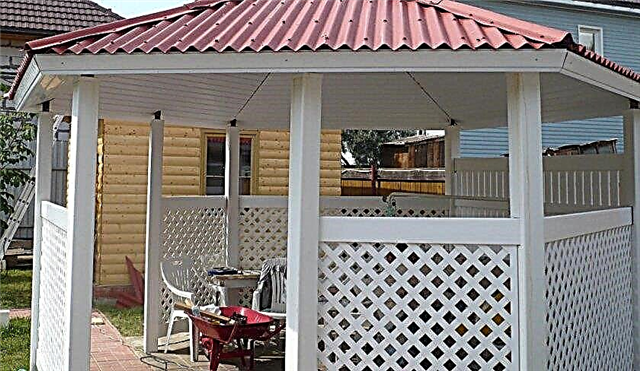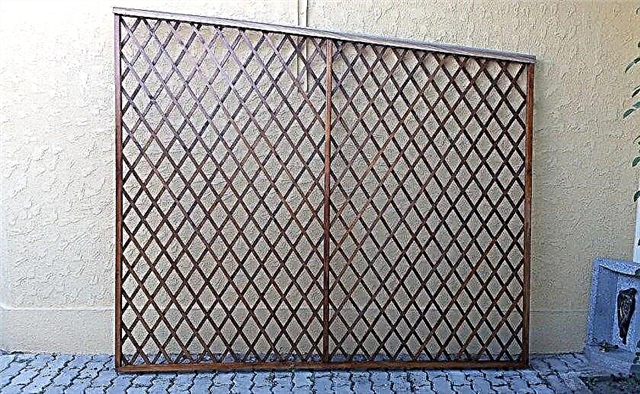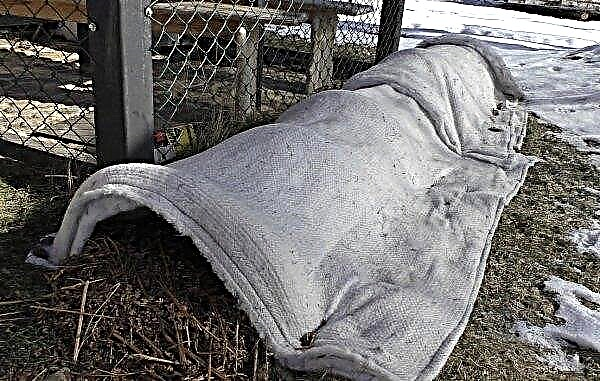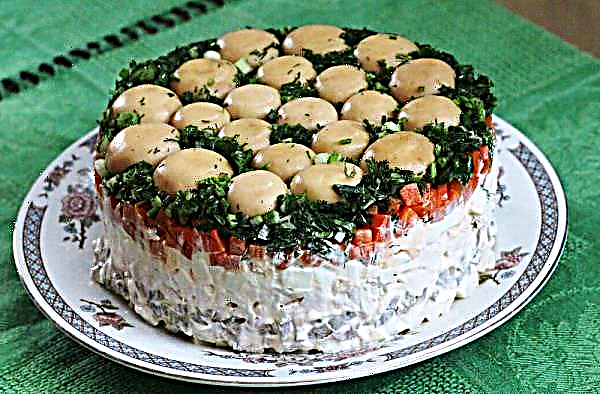The lattice in the gazebo performs not only a decorative function. It plays the role of a partition, hiding the people sitting in it from prying eyes and sunlight, and also serves as a support for climbing plants used to decorate the building. Such an element is easy to make with your own hands.
Types of Gratings
There are several types of gratings for arranging gazebos on a summer cottage or personal plot:
- Plastic. Very easy to care for and easy to install. Their surface does not need to be treated with special coatings, painted. They are resistant to environmental influences - they do not rot from rain. On sale you can find a variety of different configurations and colors. Such trellises, when landing next to hanging hanging vines, which will be woven along them, will last much longer.

- Metal. Metal gratings are very reliable and stable, but heavier and more expensive in price. Forged lattices with different patterns are very beautiful. They are almost eternal, but their surface must be treated with special compounds from corrosion. They combine well with wood and stone, and are most relevant if there are other forged items on the site (fence, barbecue, lantern, bench).

- Wooden. Completely natural and environmentally friendly building material. They look very nice and cozy. For arbors, you need to choose wood that is more resistant to external factors (rain, snow, frost). Best suited oak, ash, larch, pine. Such a grate for the gazebo can be made with your own hands from suitable wooden blocks. The tree must be treated with special coatings that increase resistance to the influence of natural phenomena. This crate can be painted in any color with paint or varnished.

Wooden lattices have their own characteristics, and can be of the following types:
- In the form of a rhombus. This form is given to the product by slats mounted diagonally (usually 45 °).
- Chevron. In this case, the trellises form sloping slats that abut against the frame racks.
- Square. Planks are attached vertically and horizontally, forming a square decorative lathing.
- Mill. In this embodiment, the slats form a fan-shaped pattern at an angle.
It is wooden trellis that is often used to equip such a variety of arbors, such as pergola.
Did you know? Pergola is a canopy structure. Supports of this design are made of arched sections, which are repeated and interconnected by bars. Initially, the ancient Romans began to make them for vines, and then they began to use the design to protect them from sunlight in the heat and create shade.
Preparatory work
The easiest way to do it yourself is to make a wooden grid. To create a simple wooden structure for a gazebo, you need a certain set of available tools and materials. It’s great if you already have them, as well as experience with them. Before purchasing material and starting work, you should take measurements and draw up drawings. On them it is easier to calculate the exact amount of timber.
Selection of materials
To make a grate, first of all, you need to choose the right wood:
- Beech. More rare option. It is quite resistant to moisture and also looks good.
- Ash. Such wood has a lighter color and a more pronounced texture.
- Larch. The most moisture resistant wood material. It does not rot and does not need rain cover.
- Pine. Wood has a more flexible structure. Due to the presence of resinous substances, it is more antibacterial and well protected from moisture.
- Birch tree. It is easy enough to handle, but not as resistant to external influences as the above options.
- Oak. The best option, but also the most expensive for the price. The wood of this kind of wood is very durable and looks beautiful in aesthetic terms.

For a wooden lattice, bars in a section of 2 × 4.5 cm, as well as smaller planks of 2 × 1 cm, are suitable. Pine will be a more budgetary and acceptable material.
It will also be necessary to purchase related materials:
- self-tapping screws and nails for connecting planks and wooden bars;
- varnish or paint at its discretion, but is mandatory for outdoor conditions;
- moisture resistant adhesive;
- special antiseptic;
- mosquito net.
Did you know? Among the Slavs, the oak symbolized strength and was considered the tree of the pagan god Perun. They called him that - Perunovo tree.
Necessary tools
To create a lattice with your own hands, you will need a tool:
- screwdriver;
- hammer;
- hacksaw and chisel;
- file or jigsaw;
- ruler and square
Wood of poor quality is sanded with sandpaper or a special machine. Then all the details need to be treated with an antiseptic in order to protect from insect pests and protect from moisture.

Step-by-step construction
The first step is to assemble the frames, and then make the grooves and the crate. At the same time, their connections and weaves at a certain angle are important, therefore, the marking should not be neglected. It is important to choose the right paint or varnish that is most suitable for the design.
Frame creation
The frame for the lattice is assembled from a bar with a section of 2 × 4.5 cm. For her, cut the necessary size pieces. Their ends are cut off with a hacksaw at an angle and interconnected by nails. In this way, all frames are assembled for the desired number of grids. In the process, it is imperative to ensure that a right angle is obtained at the joints.

Milling and sawing
On the assembled frame, grooves (folds) are made, into which rails from a finer beam section will be inserted. They must be done based on the size of the nailed strips and their location. Trims for the grate of the gazebo can be attached along the side walls or crosswise at right angles. For this, markings are marked with pencil in the joints. Grooves are best done on the machine, since manual processing does not always give the required accuracy. Then cut the slats of the desired size.
Important! The same distance should be maintained between the racks of the grill, otherwise they will not have a particularly neat appearance.
All these works can be simplified by nailing cut-in-size strips flush to the frame, cutting off their angles at 45 ° (for fastenings crosswise).

Grid assembly
Further grid collection is simple. This is done step by step:
- Planks of small cross section (1 × 2 cm) are attached to the frame in prepared and marked places with nails. The slats should be at right angles to each other.
- Sticking edges are cut.
- Filled frames are attached to each other or at the installation sites with screws.

Painting
Assembled wooden structures should be painted. This will significantly extend the time they are used. Usually use paints and varnishes for wood. They are applied in several layers. Many people prefer varnishing wooden structures to emphasize the natural beauty of the material. For more economical use of coloring agents, it is first recommended to treat the tree with linseed oil.
Grid decoration
The cross-shaped crate of the planks itself already gives a beautiful effect. It is enhanced by a well-chosen tone of paint or varnish. There are also special impregnations that enhance the natural pattern on wood. Sometimes, certain equipment before painting along the edges make patterned elements in the form of teeth or waves. If there is no way to do it yourself, then you can contact the carpentry workshop or process the trims before assembly. Often, mosquito nets are inserted into the gazebo to prevent insects from entering the structure.

For the most beautiful design, arbors with trellises are planted with climbing plants next to them. Often the crate is placed precisely for their sake, since the vines are well-worn on such structures. Most often grapes are planted nearby (maiden or arbor cultivars), ivy, climbing roses, clematis, hops. The most unpretentious plant, almost maintenance-free, fast-growing and well-growing, is considered a girl's grape.
Important! The type of plant is selected based on the climate of the area where the gazebo is installed, its growing characteristics and ability to grow. Sometimes the main purpose of planting them is not decoration, but getting a thick shadow.
The grid is an excellent decorative element of the gazebo. It can be bought or made with your own hands, decorated with well-chosen paint or varnish, and the curly plants planted nearby will give the structure the most advantageous look.















